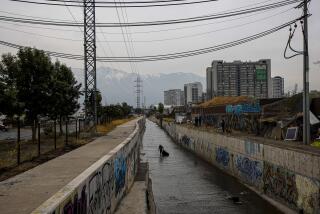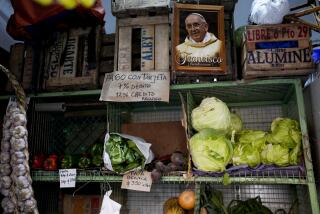From Argentina to Chile by Bus and Ferry
- Share via
BARILOCHE, Argentina — Chile and Argentina nearly went to war in 1978 over a long-festering border dispute, but those animosities have given way to increasingly healthy relations.
For the traveler, this means the opportunity to include both countries in a single visit.
One of the most exhilarating ways to do so is to make the one- or two-day crossing from Bariloche, in southeastern Argentina, to Puerto Montt in south-central Chile. In the space of just 210 miles by bus and ferry, travelers cross emerald-toned, deep-water lakes, ascend the Andes Mountains, glide alongside the perfect cone of the Osorno Volcano and 11,800-foot Tronador Mountain, and visit a cascade through hardened lava.
The climatic changes are as dramatic as the landscape. The semi-arid Patagonian steppes just east of Bariloche give way to an almost perpetually damp and dense jungle and cloud forest near the heights of the Andes, back down into the temperate lake district of Chile. No wonder Argentines in particular like to escape to Bariloche in the summer. When I left Buenos Aires, it was 101 degrees; in Bariloche, the day began at a brisk 47 degrees, warming to the mid-60s.
You can set out on the crossing from either Puerto Montt or Bariloche, both of which are reachable from their respective capitals, Santiago and Buenos Aires, via several daily flights.
The Andina del Sur travel agency handles arrangements in Chile, and Catedral Turismo is the Argentine agent. Both work with national and international agents to make bookings.
Guides offer commentaries throughout the journey, in both Spanish and English, for the 300 or so people who make the crossing each day in the warmer months (December to March). Those on longer trips with lots of baggage needn’t worry; the crews move the bags from each of the three ferries onto the buses, and into the customs shed for a quick inspection at the border.
Bariloche, with a surging population of 60,000, is as much a winter ski resort (June-August), attracting many North American addicts, as it is a summer lake retreat. The town, on the shore of the long, slender Lake Nahuel Huapi, is within the national park of the same name, covering 1.8 million acres up against the Chilean border.
Ten different day-tours are available from travel agents to sites, including one to 12-mile-long Victoria Island, full of bird life such as cormorants, “royal turkey” and pheasants. In some parts of the park, condors soar overhead. Another brief side trip is the chairlift trip to the top of 3,300-foot Campanario Mountain, for views of the entire lake district.
The tour companies collect travelers from their hotels for the crossing. From Bariloche, buses take you to Panuelo for the ferry trip (passengers only) up the Puerto Blest arm of the lake through a sheer-walled cut in the mountains. The modern, rapid boat has big cabin windows, which is useful because it can get frigid on deck.
You alight and board waiting buses for a short ride through triple-canopy highlands jungle, where some trees are more than 2,000 years old and 120 feet or more in height. Boarding a less majestic craft, you make a brief crossing of Lake Frias, where the tallest mountain in the area, 11,800-foot Tronador, sweeps into view if the day is clear.
On shore, you arrive at the Argentine immigration office for a courteous if lengthy passport-stamping. Chilean guides then take over as the bus ascends the 3,200-foot pass and enters Chile’s Vicente Perez Rosales National Park, where the roadside is bright with native orange orchids.
After clearing Chilean immigration and customs, lunch is served at Puelle before passengers set off on the two-hour crossing of All Saints Lake, the pride of the Chilean Lakes District whose highlight is salmon and trout fishing and the Osorno Volcano, which last erupted in 1850. Chile has more than 2,000 volcanoes, 10% of the world total. All Saints Lake, more than 1,000 feet deep, is emerald-colored from the minerals washing down from the mountains.
Back aboard more comfortable buses for the final couple of hours through farm country to Puerto Montt, the bus pauses at a waterfall and then skirts the large Llanquihue Lake before arriving at the town of Puerto Varas. In this area, German settlers make up almost a third of the population. Homes of distinctive yellow-painted wooden shingles and red zinc roofs offer what Chileans regard as an Alpine atmosphere.
By evening, the buses reach Puerto Montt, a busy port city of 125,000 that is benefitting from Chile’s export boom in salmon, wood and other products, although it still feels like a small town by the sea.
The fare for the one-way trip is about $20 U.S.
In Puerto Montt, the best hotel is the Vicente Perez Rosales, (about $70 U.S., double), but several others, including the Hotel Colina (about $45, double), are also pleasant.
More to Read
Sign up for The Wild
We’ll help you find the best places to hike, bike and run, as well as the perfect silent spots for meditation and yoga.
You may occasionally receive promotional content from the Los Angeles Times.






